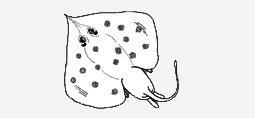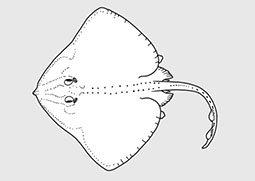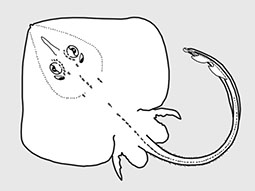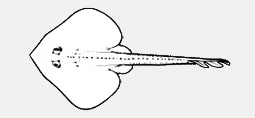
Anacanthobatidae - (Smooth skates)
A terminal filament of varying length arising from a small, bluntly rounded protuberance at the tip of the snout. Dorsal fins absent, but membranous caudal fin present. Five pairs of small, ventral gill slits. Dorsal and ventral surfaces of disc smooth, without dermal denticles. Tail slender, a bit shorter than disc. Small skates of slope regions in tropical/subtropical waters. Known from South Africa, Natal, and the tropical western Atlantic; also from Taiwan (Ref. 7465). Distribution: Northwestern Atlantic, Southern Indian Ocean, Western Pacific. Common name: Legskates Habitat: continental and insular slopes (Ref. 117112).

Arhynchobatidae - (Softnose skates)
Benthic rays occurring in all oceans, from Arctic to Antarctic waters and from shallow coastal shelfs to abyssal regions; rare in tropical shallow waters or near coral reefs; some species enter brackish waters. Disc quadrangular to rhomboidal. Mouth transversed to arched, with numerous teeth. Five pairs of ventral gill slits. Tail very slender, with lateral folds, usually 2 reduced dorsal fins and a reduced caudal fin. Electric organs weak, developed from caudal muscles. Skin prickly in most species, the prickles often in a row along midline of dorsal. Oviparous; eggs in a horny capsule with four long tips. A reversal to egg-laying from live-bearing was observed in this group based on fossil records (Ref. 50449). Skates feed on other

Gurgesiellidae - (Pygmy skates)
Benthic rays occurring in all oceans, from Arctic to Antarctic waters and from shallow coastal shelfs to abyssal regions; rare in tropical shallow waters or near coral reefs; some species enter brackish waters. Disc quadrangular to rhomboidal. Mouth transversed to arched, with numerous teeth. Five pairs of ventral gill slits. Tail very slender, with lateral folds, usually 2 reduced dorsal fins and a reduced caudal fin. Electric organs weak, developed from caudal muscles. Skin prickly in most species, the prickles often in a row along midline of dorsal. Oviparous; eggs in a horny capsule with four long tips. A reversal to egg-laying from live-bearing was observed in this group based on fossil records (Ref. 50449). Skates feed on other benthic organisms. Skate wings are considered good eating. The following subgenus have been elevated to the genus level: Amblyraja, Dipturus, Fenestraja, Leucoraja, Okamejei, Rajella, Rostroraja (Ref. 27314).
Note: Families with unknown counts of dorsal or anal spines are also included
